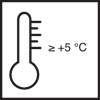Article No. 687814
Injection resin for flexible injection of cracks in manure/slurry and wastewater facilities, D-I (P)
Product specifications
Component A
Component B
Once fully cured
The stated values represent typical product characteristics and are not to be construed as binding product specifications.
Field of application
- Crack injection in concrete according to DIN EN 1504-5
- Classification: U(D1) W(3/4/5) (1/2/3/4*) (5/30) *Water-bearing cracks must be pre-injected with IR PUR 2K rapid!
- Moisture level: DY, DP, WT, WF*
- Waterproofing cracks and construction joints in manure/slurry and wastewater facilities
- Crack injection in drinking water tanks
- Building waterproofing during construction
- Horizontal impervious layers and waterproofing in masonry
- Sealing of damp and water-bearing cracks
- Filling voids in masonry/concrete after water ingress
Properties
- Resistant to biogenic sulphuric acid (BSA corrosion)
- Compliant with KTW recommendation
- High chemical resistance
- Total solid (Similar to the testing method of Deutsche Bauchemie e.V.)
- Fire behaviour B2 pursuant to DIN 4102-4
- Low viscosity
-
Preparation
-
Substrate requirements
The flanks of the crack must be dimensionally stable and free from loose parts, sintered layers, oils, grease and other separating substances.
-
Preparations
Plug the path of the crack if necessary.
Use a suitable packer.
-
-
Application
-
Using suitable injection technology, inject the material from bottom to top.
Remove packer, seal boreholes if necessary.
-
Application instructions
-
Conduct an analysis of the structural condition prior to injection.
Adjust the injection pressure according to the properties of the building component.
Inject again if necessary.
Conduct any subsequent injection within the working time.
When injecting into vertical or overhead cracks, tamp the run of the crack.
Remove the skin that forms as a result of reaction with humidity and do not mix in.
When using in large cavities, select a suitable injection quantity based on the component properties on account of the significant increase in the volume of the material.
As a general principle, higher temperatures will reduce and lower temperatures will increase the times stated.
-
-
Working tools / cleaning
-
1K pump, patent disperser, suitable packers, hammer drill
-
Clean tools, equipment and splashed material immediately while fresh with V 101.
More detailed information can be found in the Remmers Tool Programme.
Take suitable protective and waste disposal measures when cleaning.
-
-
Usage
-
- To be determined on a case-by-case basis
- Dependent on the moisture level in the structure, crack width and component thickness
- Approx. 1.1 kg/l void
- Approx. 0.4-0.7 kg/running metre
-
-
General information
-
Unless otherwise specified, all of the values and application rates given above have been determined under laboratory conditions (20 °C). Slight deviations from these values may arise if the product is worked with on site.
The actual amount of material needed depends on the size of the void. Proceed based on the results of the building condition analysis.
Remember that surplus material may be needed depending on the application method.Do not allow condensation to form in the injection device.
Once the work is finished, thoroughly empty and clean the injection device.
-
-
Disposal instructions
-
Larger quantities of leftover product should be disposed of in the original containers in accordance with the applicable regulations. Completely empty, clean containers should be recycled. Do not dispose of together with household waste. Do not allow to enter the sewage system. Do not empty into drains.
-







